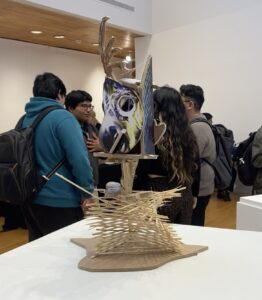
Rutgers-Newark design students created a sculpture made of bio plastic, wood, and recycled materials. (Photo courtesy of Cezar Regala)
This story was produced in collaboration with CivicStory as part of the NJ Ecology-Civics Reporting Project.
Graphic Design students and faculty at Rutgers Newark’s School of Arts and Sciences aren’t just making art—they’re making their own materials. Starting in the Fall 2024 semester, eco and bio art were integrated into the 3D Design course, allowing students to find and create sustainable, eco-friendly materials for sculpture and design.
In the bustling halls of Express Newark, art students in this class double as STEM students, taught by Professor of Professional Practice and artist Emanuele Cacciatore. From measuring out chemicals to cultivating fungi, students are creating sustainable sculptures that blend art, biology, and chemistry.
On tables: laptops loaded with design software, precision measuring tools, and an assortment of natural chemicals form an unusual artist’s palette.
“I never thought I’d be farming or synthesizing materials for my work,” said Mattheus Cueva, a junior studying graphic design and art history. “It has changed my perspective on art and the power we have as artists to consider the impact our materials have.”
Traditional plastics made from fossil fuels maintain their durability and shape, but their decomposition process can take centuries. Biodegradable bioplastics, however, are designed to decompose naturally into simpler substances—such as water, carbon dioxide, and biomass—according to a 2024 study published in PeerJ.
One of the principal materials students work with is mycelium, the root-like structure of fungi.
“You can grow it [mycelium], and artists are using it to make sculpture,” Cacciatore said. “You can use this [mycelium] because it biodegrades much faster than cardboard. It’s actually cheaper to make.”
In a 2022 study published in the National Library of Medicine, materials made of fungal mycelium and the organic substrate are unlike many traditional building materials in that they are emission-free, nontoxic, low-cost, and recyclable.
The idea for the initiative began in the summer of 2024 during conversations between Anonda Bell, Director and Chief Curator at the Paul Robeson Galleries, and Assistant Teaching Professor Keary Rosen. Cacciatore recalls that Bell mentioned she had been working with bio-based materials in her own art practice. This sparked interest in exploring similar approaches within the 3D Design course.
Inspired by the exchange, the colleagues began experimenting with homemade bioplastics. After numerous trials and errors, their summer experiments proved successful.
“We had to test different recipes over and over,” Cacciatore said, “but eventually we developed a working process that we could bring into the classroom.”
Cacciatore explained that over the course of the first semester, he refined both the material process and the way he taught it.
“This is chemistry, so what we’re doing needs to be precise,” he said. “One extra ounce of gelatin and you have slime that smells like a farm.”
The bioplastic-making process starts with a base of glycerin, gelatin, and an organic thickener such as corn starch. The mixture is heated to initiate a chemical reaction. While it’s still hot and malleable, it’s poured into molds and left to cool and solidify into sculptural forms.
In contrast, growing mycelium requires a more delicate and controlled process.
“You need to be extremely clean and disinfect everything,” said Cacciatore. “It seems weird, because fungus—you think, Oh, they’re growing in anything—but it needs a completely sterile environment to grow in.”
Students are required to wear rubber gloves and disinfect their work surfaces before handling spores. Once inoculated, the mycelium are put into molds of students’ design and are left to grow in a dark, humid space where they eventually take shape.
This hands-on learning experience gives students practical skills in both science and art while encouraging them to reflect on the full lifecycle of the materials they use. The program merges scientific laboratory work with graphic and 3D artistic practices through a hybrid curriculum that bridges completely separate fields of study.
“Before we could even create with the bioplastics or mycelium, we had to go through processes of making them ourselves,” Cezar Regala, a junior in the 3D Design class, said. “It was an incredibly valuable class, asking us to think both creatively and scientifically in a way to consider what exactly our materials are before we use them.”
Cacciatore says these first two semesters have been a trial and error, both in the curriculum and in practice. In future iterations of the course, he hopes to incorporate new materials, including a living, color-changing pigment that’s triggered by adding bacteria.
“Every year, more things are discovered. Like the material we’re using—this is kind of growing and growing off of itself,” he said. “So as the science evolves, so will the class.”
This story was produced in collaboration with CivicStory as part of the NJ Ecology-Civics Reporting Project.

Naim Ali-Pacheco is a 2025 CivicStory Ecology-Civics fellow and is a graduate of Rutgers-Newark.
